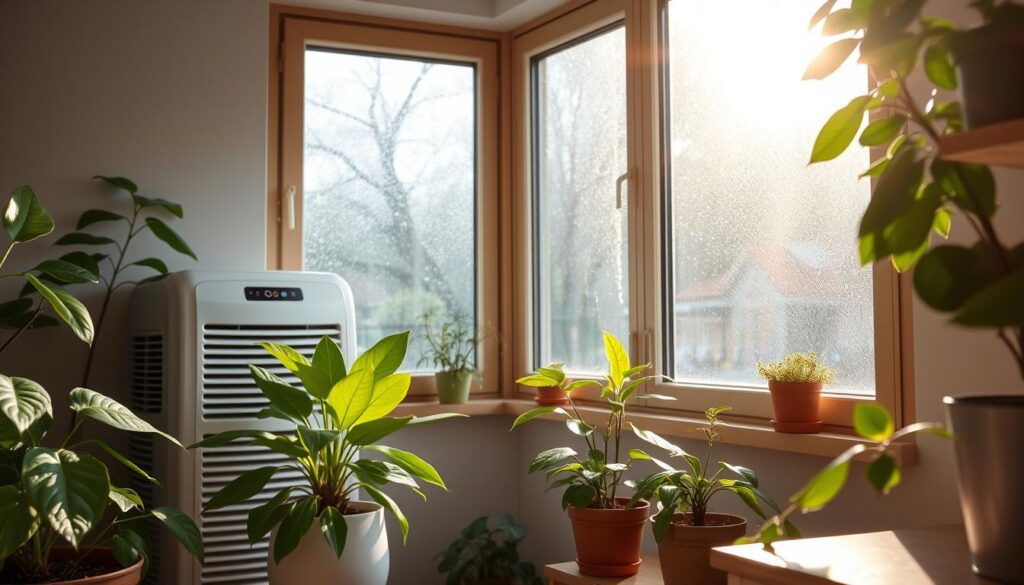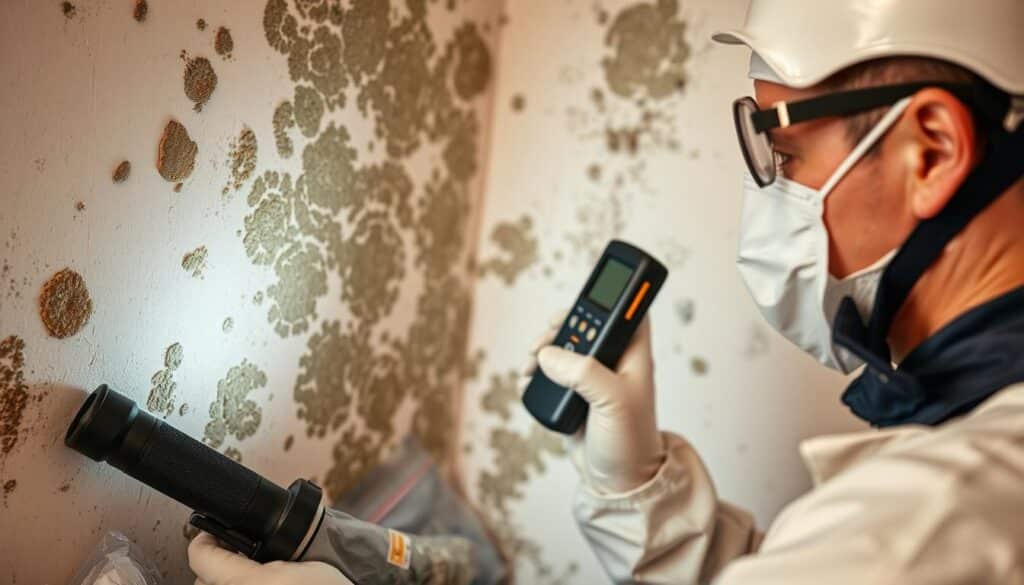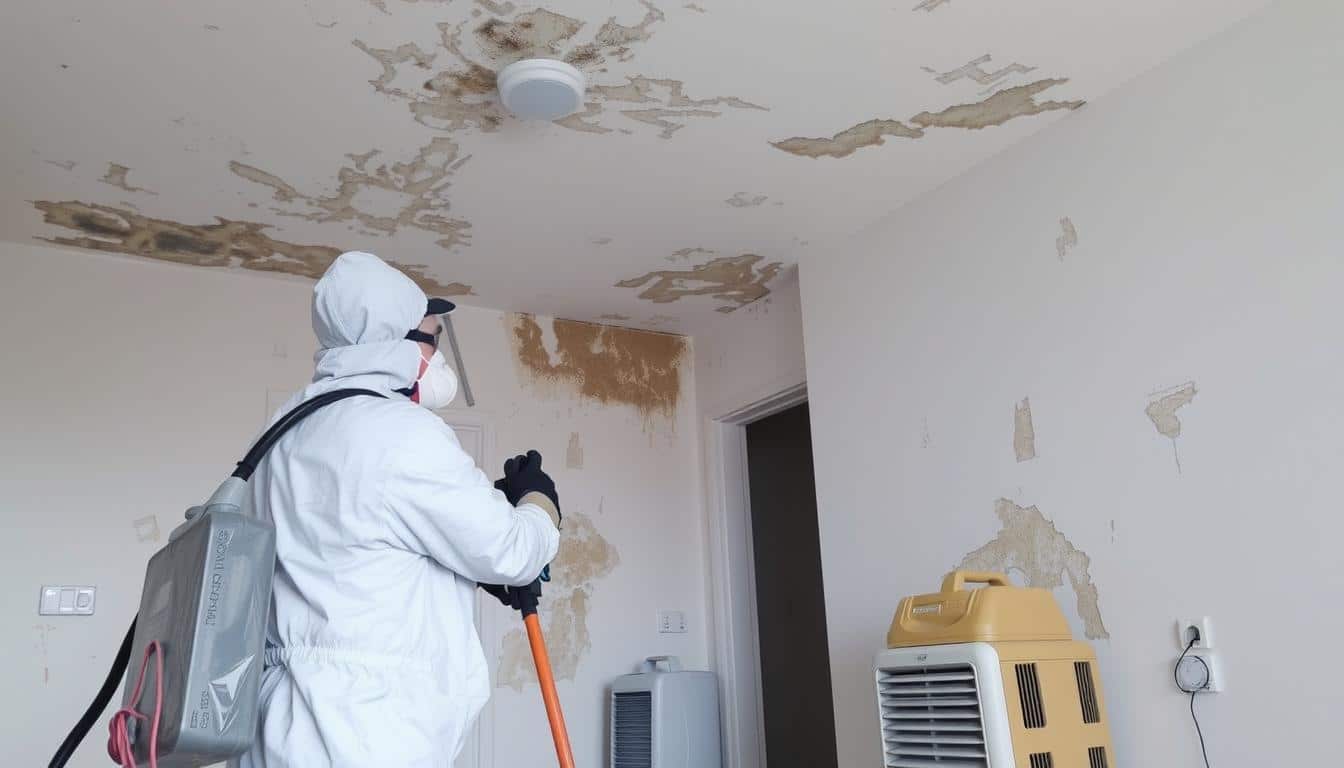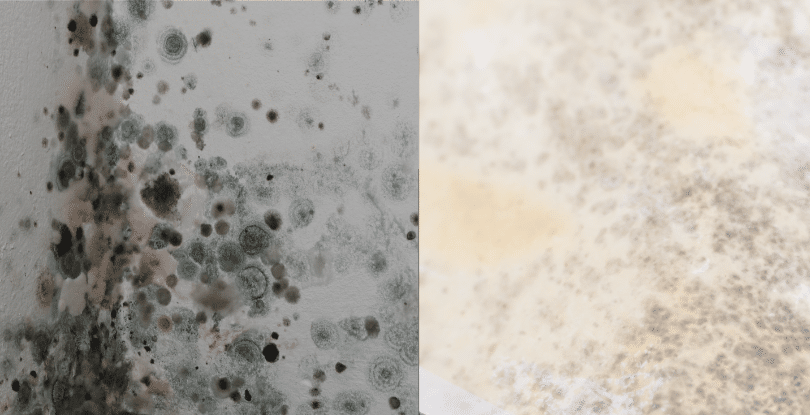As a homeowner, dealing with mold can be a serious and daunting challenge. Mold is not only unsightly, but it can also pose significant health risks if left unchecked. Understanding the difference between mold mitigation and mold remediation is crucial in effectively addressing mold problems in your home.
Mold mitigation focuses on preventing the spread of mold and reducing its impact on your property. This is done through various preventive measures, such as sealing cracks, improving insulation, and ensuring proper drainage. On the other hand, mold remediation is the process of removing existing mold growth and restoring the affected areas to a clean and healthy condition.
Key Takeaways:
- Mold can start growing in a property as quickly as 48 hours after water intrusion.
- Mold mitigation aims to prevent the spread of mold and reduce its impact through moisture control and preventive measures.
- Mold remediation is the process of removing existing mold growth and restoring the affected areas.
- Mold can pose significant health risks, and both mitigation and remediation are essential for addressing mold problems.
- Mold Remediators USA, a leading mold remediation company, has over 2,260 locations in the United States and Canada.
Introduction to Mold Problems
Mold is a big problem that can harm your property and health. It grows well in damp, humid places. This can cause mold damage and bad indoor air quality. It’s important to know how serious mold problems are because it can be harmful to your health.
Why Mold is a Serious Issue
Mold is more than just a cosmetic issue; it can seriously damage your home. It can weaken walls, floors, and even the foundation. Also, mold spores in the air can cause allergies and breathing problems, especially for those with weak immune systems or health issues.
Health Risks Associated with Mold
- Nasal congestion and sinus irritation
- Coughing, wheezing, and chest tightness
- Skin rashes and eye irritation
- Headaches, fatigue, and difficulty concentrating
- Exacerbation of asthma and other respiratory conditions
Mold exposure can also lead to serious health problems like neurological deficiencies and chronic respiratory diseases. It’s crucial to act quickly to fix mold issues to protect your family’s health.
“Mold can grow indoors in various types such as Cladosporium, Penicillium, Aspergillus, Alternaria, and Stachybotrys chartarum.”
What is Mold Mitigation?
Mold mitigation is a way to stop mold from growing and spreading in your home. It’s different from mold remediation, which removes mold completely. Mitigation aims to control mold and lessen its effects. It involves finding and fixing the mold’s causes, taking steps to prevent it, and keeping your home’s conditions right to stop mold.
Key Points About Mold Mitigation
- Identifying and addressing sources of moisture that can lead to mold growth, such as leaks, high humidity, or poor ventilation.
- Implementing preventive measures like sealing cracks, improving air circulation, and using dehumidifiers to maintain optimal indoor humidity levels.
- Conducting regular inspections and monitoring to detect any signs of mold early and address them promptly.
- Educating homeowners and occupants on the importance of mold prevention and the steps they can take to maintain a healthy indoor environment.
Importance of Moisture Control
Keeping moisture under control is key in mold mitigation. Mold loves damp places. Keeping humidity levels between 30-50% and fixing water leaks quickly helps stop mold. By managing moisture well, you can lower mold risks and avoid expensive remediation later.

Mold mitigation is a smart and affordable way to handle mold in your home or business. By controlling moisture and taking preventive steps, you can protect your property and keep it healthy for everyone living there.
What is Mold Remediation?
Mold remediation is a detailed way to deal with mold growth. It makes a property clean and healthy again. It’s different from mold mitigation, which is about preventing mold before it starts.
The process includes steps like assessment, containment, removal, cleaning, and restoration. It aims to get rid of mold safely and restore areas to their original state. It also stops mold from coming back.
When mold spreads a lot or gets into hard places, remediation is needed. It’s a deeper fix than mold removal. Mold removal only deals with the visible mold and doesn’t fix the moisture problem.
Experts use special tools and methods for mold remediation. They make sure mold is safely removed and the moisture problem is fixed. This way, they offer a lasting solution and reduce mold coming back.
“Mold remediation is the best way to ensure a property is truly mold-free and protected from future growth.”
Mold remediation tackles moisture issues and prevents mold. It makes living or working spaces healthier and more lasting.
Key Differences Between Mitigation and Remediation
When dealing with mold, there’s a big difference between mitigation and remediation. Mold mitigation is about stopping mold before it starts. It involves controlling moisture and keeping the air clean. Remediation, on the other hand, is for when mold is already a problem.
Proactive vs. Reactive Approaches
Mold mitigation is all about being ahead of the game. It means controlling moisture and keeping the air clean. This way, you can stop mold before it becomes a big issue.
Mold remediation, however, is for when mold is already a problem. It involves a detailed process to get rid of the mold. This includes assessing the damage, containing the area, removing moldy materials, and cleaning everything thoroughly.
Scope of Work Involved
Mold mitigation is less work than remediation. It might include fixing moisture issues or improving air flow. The goal is to keep mold from spreading.
Mold remediation, however, is a bigger job. It requires a detailed plan to remove mold and restore the area. This includes assessing the damage, containing the area, removing moldy materials, and cleaning everything thoroughly.
Knowing the difference between mitigation and remediation helps homeowners and property managers make the right choice. It ensures mold problems are handled effectively and don’t come back.
What is the difference between mold mitigation and mold remediation?
It’s important to know the difference between mold mitigation and remediation. These two methods help deal with mold in homes or buildings. They have different goals and need different approaches.
Mold mitigation aims to stop mold from spreading. It uses moisture control and preventive steps. This way, mold growth is prevented before it becomes a big issue. Companies that focus on mitigation offer long-term solutions like protective coatings and dehumidifiers.
Mold remediation is about removing mold that’s already there. It makes areas safe and healthy again. Remediation services include mold inspection, dehumidifying, and cleaning. They also involve removing moldy materials and applying antimicrobial agents.
| Mold Mitigation | Mold Remediation |
|---|---|
| Focuses on preventing the spread of mold and reducing its impact | Involves the physical removal of mold and contaminated materials |
| Employs moisture control and preventive measures | Includes steps like mold inspection, containment, and cleaning |
| Offers long-term solutions to prevent future mold growth | Addresses mold issues that have already occurred |
| A proactive approach to mold management | A reactive approach to address existing mold problems |
Knowing the difference between mold mitigation and remediation is key. It helps create a plan to tackle mold problems. By using both strategies, we can manage mold and stop it from coming back.
Mold Inspection and Assessment
Dealing with mold needs a detailed mold inspection and assessment. As a professional mold inspector, I use many methods to find out the mold type and how much there is. I also look for the moisture sources that cause the problem.
Identifying the Type and Extent of Mold
The first thing I do is a thorough visual check. I look closely at the affected areas to see if mold is there and what kind it is. I also take air and surface samples for lab tests to know the mold species. Knowing the mold type is key because some are more dangerous than others.
Next, I do moisture tests to see why mold is growing. This might mean using special tools to check humidity, find water leaks, and spot other moisture sources. This helps me understand the mold problem better.
Evaluating Moisture Sources
- Finding out why moisture is getting in, like leaks or high humidity, is very important in mold assessment.
- Knowing the moisture sources helps me plan how to fix the mold problem. This way, I can stop mold from coming back.
- Doing detailed moisture tests and analysis makes sure we fix the mold problem at its root. It’s not just about treating the symptoms.
Doing a thorough mold inspection and assessment is key to managing mold. By knowing the mold type, how much there is, and the moisture sources, I can suggest the best ways to fix it. This helps make the indoor environment healthy again.
| Key Mold Assessment Metrics | Findings |
|---|---|
| Mold Species Identified | Aspergillus, Penicillium, Stachybotrys |
| Estimated Affected Area | 500 square feet |
| Moisture Sources Detected | Leaking roof, high indoor humidity, poor ventilation |

“Proper mold assessment is the first critical step in addressing mold issues and preventing future growth.”
Containment and Air Filtration
When fixing mold, it’s key to stop it from spreading. Experts use special methods to keep the area safe. This makes sure the indoor space stays clean.
They start by setting up special zones. These areas are sealed off with plastic sheeting. They also use air systems to keep mold spores from moving around.
Advanced air filters, like HEPA filters, are also used. These filters catch tiny mold spores, making the air safer.
Good containment and air filters are crucial. They keep people safe and help fix the mold problem. This way, the indoor space becomes healthy and free of mold.
Effective mold containment and air filtration are the foundations of successful mold remediation. Without these critical steps, the problem can quickly spiral out of control.”
Using mold containment and air filters is key to keeping the air clean. It helps experts solve the mold issue for good. This stops mold from coming back.
Mold Removal and Cleaning Processes
Dealing with mold in a property needs careful mold removal and cleaning steps. It’s not just about getting rid of visible mold. We also aim to find and clean any hidden mold, making the area safe and healthy again.
Safe Removal of Contaminated Materials
The first step is to safely take out any moldy materials like drywall, insulation, or flooring. Mold loves to grow in these materials, so they often need to be thrown away. Mold remediation teams use special tools and methods to keep the mold from spreading while they work.
Disinfecting and Deodorizing Affected Areas
After removing moldy materials, the area gets a deep clean. This includes using special cleaners to kill any leftover mold and get rid of bad smells. HEPA vacuums are used to pick up tiny mold spores, making sure everything is clean.
This cleaning and mold removal process is key to fixing mold problems. By removing moldy materials and cleaning the area well, homes or businesses can be made safe and free from mold. This helps prevent mold from coming back.
“Mold has been linked to various respiratory illnesses such as asthma or bronchitis and causes allergic reactions.”
Trying to remove mold yourself is not safe and can be very risky. It’s best to get help from a certified mold remediation expert. They know how to safely and effectively clean up mold.
Preventing Future Mold Growth
To keep your home mold-free, you need to act early. Fixing moisture problems is key. This means fixing leaks, improving air flow, and ensuring water doesn’t collect around your home’s base. Regular checks, watching humidity, and quick action to water issues can stop mold before it starts.
Addressing Underlying Moisture Issues
Mold loves damp places, so fixing moisture problems is crucial. This includes:
- Fixing leaks in the roof, walls, or plumbing
- Improving ventilation in bathrooms, kitchens, and other high-moisture areas
- Ensuring proper drainage around the home’s foundation to prevent water accumulation
- Monitoring and controlling indoor humidity levels, keeping them below 50%
Ongoing Maintenance and Monitoring
Staying alert and checking regularly is vital. Homeowners should:
- Look for mold or moisture signs often
- Use humidity meters to check moisture levels
- Quickly fix water problems or high humidity
- Keep ventilation systems clean and working well
By tackling moisture issues and staying proactive, you can keep your home mold-free. This ensures a healthy living space for years to come.
| Mold Prevention Strategies | Moisture Control Measures | Long-Term Mold Management |
|---|---|---|
| Fixing leaks | Improving ventilation | Regular inspections |
| Controlling humidity levels | Ensuring proper drainage | Prompt attention to moisture issues |
| Maintaining ventilation systems | Monitoring indoor humidity | Ongoing maintenance and monitoring |
“Mold mitigation has been shown to reduce the likelihood of mold regrowth by up to 70% compared to homes that have not implemented mitigation measures.”
When to Hire Professional Mold Remediation Services
Dealing with mold can be tough. That’s why it’s smart to get help from mold cleanup experts. Mold can hurt your property value and health, so it’s important to fix it fast and right.
DIY mold removal might seem cheap for small problems. But, it often can’t get rid of all the mold. Mold pros have the right tools, training, and know-how to safely and fully remove mold and stop it from coming back.
So, when should you call a mold remediation service? Here are some important things to think about:
- Big mold growth (more than 10 square feet)
- Mold in places you can’t easily reach
- Mold keeps coming back, showing a bigger issue
- Worried about mold’s health risks
- Planning to sell or rent a place with mold
Professional mold cleanup experts will first check out the mold problem. They’ll figure out what kind and how big it is. Then, they’ll make a special plan to fix it, which might include stopping it from spreading, removing it, and fixing any damage.
| Benefit | DIY Mold Removal | Professional Mold Remediation |
|---|---|---|
| Effectiveness | May not fully get rid of the problem | Makes sure all mold is gone and won’t come back |
| Safety | More risk of getting mold on you and spreading it | Uses the right safety gear and ways to keep mold in |
| Cost | Could be cheaper at first | Usually more expensive, but worth it for peace of mind |
| Expertise | Not much knowledge or experience | Has trained and certified pros with lots of experience |
When facing mold problems, it’s wise to choose caution and get professional mold remediation help. They offer a complete fix that not only solves the current issue but also stops mold from coming back. This keeps your home or property safe and healthy.
Conclusion
Understanding the difference between mold mitigation and remediation is key. Mold mitigation stops mold from spreading and lessens its effects. On the other hand, remediation removes mold and fixes damaged areas. By using both methods, you can keep your home mold-free and healthy for your family.
It’s important to tackle mold problems quickly and use the right methods. Mold spores are everywhere, but you can control their levels. With good mold management, you can keep your home safe and healthy.
Stay alert and fix any moisture or mold issues fast. This way, you protect your family and keep your home mold-free. With the right steps, you can overcome mold challenges and keep your home safe and cozy for years.
FAQ
What is the difference between mold mitigation and mold remediation?
Mold mitigation stops mold from spreading by controlling moisture. It uses preventive steps. Mold remediation removes mold and makes areas safe and healthy again.
Why is mold a serious issue for homeowners?
Mold can harm your health, especially if you have allergies or asthma. It can cause symptoms like coughing and skin problems. It also damages your home’s structure.
What are the key points about mold mitigation?
Mold mitigation finds and fixes moisture problems. It seals cracks and improves air flow. Regular checks and upkeep are key to preventing mold.
What is the mold remediation process?
The process includes checking, containing, removing, cleaning, and fixing. It aims to get rid of mold safely and restore your home.
How do mold mitigation and mold remediation differ in their approaches and scope of work?
Mitigation stops mold before it starts. It controls moisture and prevents growth. Remediation deals with mold already present. It involves a detailed process to remove and clean mold.
How do professionals perform a mold inspection and assessment?
Experts check the mold type and how much there is. They find moisture sources too. This helps plan the best way to fix the problem.
What are the key steps in the mold remediation process?
The process starts with safely removing moldy materials. Then, it disinfects and deodorizes the area. Experts use special tools to remove mold well.
How can homeowners prevent future mold growth?
Fixing moisture problems is key. This means fixing leaks and improving air flow. Regular checks help catch mold early and stop it.
When should homeowners consider hiring professional mold remediation services?
Getting professionals is best for mold removal. They have the skills and tools to do it right. DIY can make things worse.




